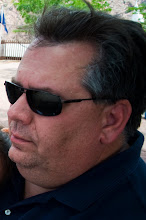Over the last several years, January was like any other month in what we call winter around these parts. Cooler than summer, but not cold by any stretch of the imagination. Cold is snow in winter...ponds freezing over... weather forecasts where the terms "life threatening" are frequently used... and that just isn't us. This year has been different though. In December and January it has snowed here. And we had enough cold weather here for every body of water in my yard - A spa, a pool and a landscaping water feature - to freeze over. The waterfall created some very interesting ice sculpture - and when I saw it, the photographer in me saw it as an opportunity to try out a few techniques that I had been studying related to off camera flash (OCF). There I was ...running around in the front yard positioning a couple of speedlights with CTO gels positioned across the lens to make it look like sunlight was reflecting off the ice sculpture.
This is stuff that I had been studying on Strobist and reading about on Joe McNally's Blog . The picture I came back with isn't about art - it is about putting more tools in my pocket for when I am out seriously making art. If you scared to death of your speedlight and you want to see how to make it your friend, reading these two blogs regularly will stimulate the right brain like nothing I have found.
Speaking of OCF, I decided to expand my skills beyond just using the Nikon Creative Lighting System (CLS) in automatic or through the lens (TTL) mode. I have the skills to use my camera in full manual mode, so it was time to learn how to use my fashes in full manual as well. I had an old pre-CLS Nikon flash that I knew could be used wirelessly with my newer state of the art flashes. I just hadn't figured out how. I came across an article in Strobist that finally made me realize what I had to do. To try it out and see if I had grasped everything properly, I pulled a very colorful Murano glass vase out of the cupboard and set up my old flash with my variant of the Justin clamp from the Manfrotto company and created this image:
While the location of the light source is no mystery in this image, what you don't see is every bit as important as what you do see. No light stand is visible - no flash unit is visible. Ms. C and my sister both regularly create floral designs and still lifes that they want photographed. I now have the tools and know-how to create a lighting solution that can be used with these items. And I have found a way to make my third flash useful. And it was this exercise (conducted in mid day in front of a bank of large open windows) that finally coalesced the concept of "killing the ambient light".
So much learned in so little time...and yet, I continued to read. I realized that lighting ,camera mechanics and composition would carry me pretty far. But I also realized that, in this digital age, it is post processing skills that will help any photographer create their "look". I have rudimentary skills in Photoshop. If you have read much in this blog, you probably already know that "good enough" is not what drives me. So, I am on a mission to develop some serious post processing game over the next year. I took a step this week by implementing a few techniques I learned from The Portrait Photographer's Handbook (Third Edition) by Bill Hurter. The lovely Ms. E very patiently sat for her slightly crazed father while he pulled out a single light set in a softbox for an impromptu portrait session. The session took 5 minutes. The post processing took 3 hours. I used every method I knew on these photos, and they are most certainly over processed. But the whole idea was to practice technique. Somewhere along the way, though, I found an image or two that may not make it to the portfolio - but they found their way into frames at home and in the office.
Who knows - maybe I was lazy in January. Maybe I was Oh-fer. I will leave it to you to decide. Personally I think that there is a lot more to learning photography than just clicking and hoping. You have the evidence. Make up your own mind on this one.
Keep the faith.








No comments:
Post a Comment